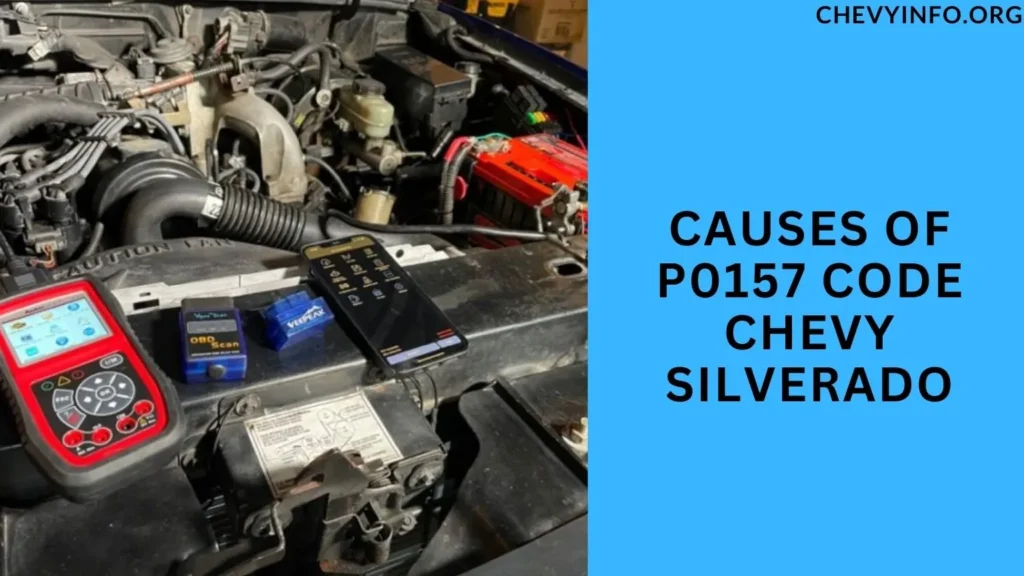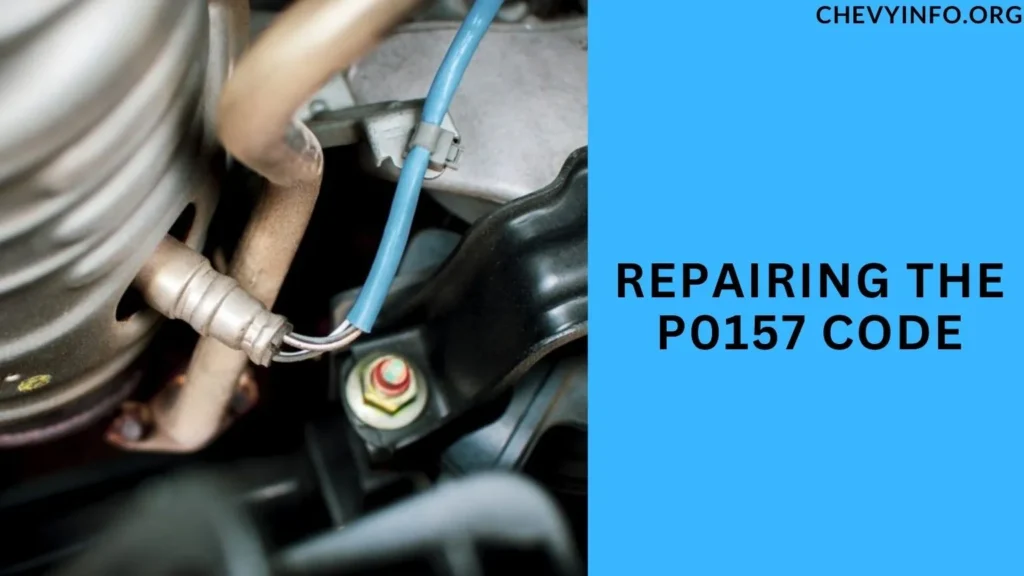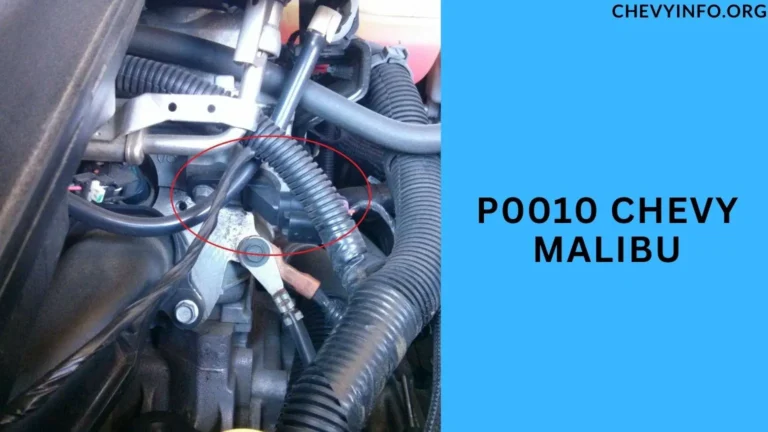P0157 Code Chevy Silverado (Mean, Causes & Fix) of 2024
Modern vehicles are equipped with onboard diagnostic systems that monitor various components for potential issues.
One common diagnostic trouble code (DTC) that Chevy Silverado owners may encounter is the P0157 Code Chevy Silverado.
Understanding this code, its causes, symptoms, diagnosis, and repair procedures is crucial for maintaining your vehicle’s performance and longevity.

Introduction to the P0157 Code
The P0157 code is a diagnostic trouble code (DTC) specific to a vehicle’s oxygen sensor circuit. It indicates a low voltage condition for the oxygen sensor in bank 2, sensor 2 of the exhaust system.
This code is commonly encountered in vehicles with onboard diagnostic systems, such as Chevy Silverado trucks.
What is the P0157 code?
The P0157 code is specifically related to the oxygen sensor circuit low voltage for bank 2 sensor 2 in your Chevy Silverado’s exhaust system.
This code indicates that there is a problem with the oxygen sensor’s voltage signal, which can affect the vehicle’s fuel efficiency and emissions.
Importance of understanding diagnostic trouble codes (DTCs)
DTCs like P0157 are warning signs that something is amiss in your vehicle’s systems. Ignoring these codes can lead to more significant issues over time and may result in decreased performance and increased emissions.
Causes of P0157 Code Chevy Silverado

The P0157 code in a vehicle, such as a Chevy Silverado, can be triggered by several underlying causes.
Understanding these causes is crucial for diagnosing and resolving the issue effectively. Here are the primary factors that can lead to the P0157 code:
Faulty oxygen sensor
One of the primary causes of the P0157 code is a malfunctioning oxygen sensor. Over time, these sensors can wear out or become contaminated, leading to inaccurate readings and triggering the P0157 code.
Wiring issues
Faulty wiring or electrical connections related to the oxygen sensor can also cause the P0157 code. Corrosion, fraying, or loose connections can disrupt the sensor’s signal and trigger the code.
Exhaust leaks
Leaks in the exhaust system, particularly near the oxygen sensor, can lead to incorrect readings and trigger the P0157 code. These leaks allow oxygen to enter the system, affecting sensor readings.
Engine misfires
In some cases, engine misfires can cause the P0157 code to appear. When the engine misfires, it can affect exhaust gases and oxygen sensor readings, leading to a low voltage signal from the sensor.
Symptoms of P0157 Code
The P0157 code in a vehicle like the Chevy Silverado can manifest through several noticeable symptoms, indicating potential issues with the oxygen sensor circuit.
Recognizing these symptoms can prompt timely diagnosis and repair, preventing further complications. Here are the common symptoms associated with the P0157 code:
Check Engine Light (CEL)
The most common symptom of the P0157 code is the Check Engine Light (CEL) illumination on your Chevy Silverado’s dashboard. This light serves as an early warning that there is a problem with the vehicle’s emissions system.
Poor fuel economy
Since the oxygen sensor is crucial in optimizing fuel mixture, a malfunctioning sensor can lead to poor fuel economy. You may notice decreased mileage per gallon, requiring more frequent refueling.
Rough idling or stalling
Sometimes, the P0157 code can cause the engine to idle roughly or stall. This occurs because the engine’s air-fuel mixture is not properly regulated, affecting idle stability.
How to Diagnose P0157 Code?
Diagnosing the P0157 code in a vehicle like the Chevy Silverado involves a systematic approach to identify the underlying cause accurately.
Here are the steps typically followed to diagnose the P0157 code:
Using an OBD-II scanner
The first step in diagnosing the P0157 code is to use an OBD-II scanner to retrieve the code and any related data.
This scanner provides valuable information about the oxygen sensor’s voltage readings and other relevant parameters.
Inspecting the oxygen sensor and wiring
Next, inspect the oxygen sensor and its wiring for any signs of damage, corrosion, or loose connections. A visual inspection can often reveal the source of the problem.
Checking for exhaust leaks
Inspect the exhaust system for any leaks, especially near the oxygen sensor. Use a smoke machine or a soap solution to detect and address leaks accordingly.
Repairing the P0157 Code

Repairing the P0157 code in a Chevy Silverado involves addressing the underlying cause accurately to restore proper functionality and clear the diagnostic trouble code (DTC).
Here are the steps typically taken to repair the P0157 code:
Replacing the oxygen sensor
If the oxygen sensor is faulty, it will need to be replaced with a new, high-quality sensor. Follow manufacturer guidelines and use OEM or recommended replacement parts.
Repairing damaged wiring
If wiring issues are causing the P0157 code, repair or replace damaged wires and connectors. Ensure all connections are secure and free from corrosion.
Fixing exhaust leaks
Address any exhaust leaks near the oxygen sensor by repairing or replacing damaged components. This will help restore proper sensor readings and eliminate the P0157 code.
Addressing engine misfires
If engine misfires are contributing to the P0157 code, diagnose and repair the underlying cause of the misfires. This may involve replacing spark plugs, and ignition coils, or addressing fuel delivery issues.
Preventing Future Occurrences
Preventing the recurrence of the P0157 code in a Chevy Silverado involves proactive maintenance and care for the vehicle’s oxygen sensors and related systems. Here are some preventive measures to consider:
Regular vehicle maintenance
Perform regular maintenance on your Chevy Silverado, including oil changes, filter replacements, and tune-ups. This helps keep all systems in optimal condition.
Using high-quality oxygen sensors
Opt for high-quality parts from reputable manufacturers when replacing oxygen sensors or other components. These parts are more durable and reliable, reducing the risk of future issues.
Checking for exhaust leaks periodically
Periodically inspect your vehicle for exhaust leaks, especially near the oxygen sensor locations. Promptly addressing any leaks can prevent the recurrence of the P0157 code.
People also ask
Can I drive my car with code P0157?
It’s not advisable to continue driving your car with the P0157 code illuminated.
Addressing the issue promptly can prevent potential damage and ensure optimal engine performance.
Where is the P0157 sensor located?
The P0157 sensor is typically located downstream (after the catalytic converter) on bank 2 of the exhaust system in a Chevy Silverado.
What would cause the low voltage on an O2 sensor?
Several factors can cause low voltage readings on an oxygen (O2) sensor:
Faulty Sensor: A malfunctioning or worn-out oxygen sensor may produce inaccurate voltage readings, leading to low voltage signals.
Wiring Issues: Damaged, corroded, or disconnected wiring and connectors related to the oxygen sensor can disrupt the electrical signal, resulting in low voltage.
Exhaust Leaks: Leaks in the exhaust system, particularly near the oxygen sensor, can introduce additional oxygen into the system, causing low voltage readings.
Engine Misfires: Engine misfires can affect exhaust gas composition, leading to irregular oxygen sensor readings and low voltage signals.
Conclusion
The P0157 code in your Chevy Silverado indicates a potential issue with the oxygen sensor circuit’s low voltage.
Understanding this code’s causes, symptoms, diagnosis, and repair procedures is essential for maintaining your vehicle’s performance and emissions compliance.
Ignoring DTCs like P0157 can lead to more significant problems over time, so prompt diagnosis and repair are recommended.

Henry Worner, a seasoned automotive expert with over 13 years of experience in car repair, maintenance, and performance enhancement, ChevyInfo.org was born out of a passion for Chevrolet vehicles. Henry’s deep-rooted love for everything Chevy has driven him to create a platform where fellow enthusiasts, car owners, and anyone interested in Chevy cars can find valuable insights, tips, and guidance.






